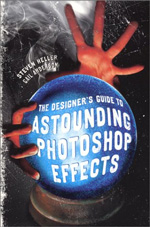 Twenty years after the desktop revolution started we find our profession more revolutionized than the proverbial desktop itself. The Mac, its growing list of software and its ease of use have put hefty power into the hands of professional designers as well as amateurs. A thought both scary and promising. Software options for designers abound: QuarkXPress, Dreamweaver, Flash, Freehand, Illustrator, InDesign and the list goes on and on. However none has had bigger impact in the design profession (as well as others) than Adobe’s Photoshop. For anyone who has used it it is no secret this is one powerful tool that, if used correctly, can yield amazing results.
Twenty years after the desktop revolution started we find our profession more revolutionized than the proverbial desktop itself. The Mac, its growing list of software and its ease of use have put hefty power into the hands of professional designers as well as amateurs. A thought both scary and promising. Software options for designers abound: QuarkXPress, Dreamweaver, Flash, Freehand, Illustrator, InDesign and the list goes on and on. However none has had bigger impact in the design profession (as well as others) than Adobe’s Photoshop. For anyone who has used it it is no secret this is one powerful tool that, if used correctly, can yield amazing results.
Most software packages for graphic designers have the ability to render any user lazy, unimaginative and, worse, a “professional”. And Photoshop is no different in this vein. Quick filters allow instant creativity and credibility. Color, contrast and hue manipulation make anybody an image expert. And layering converts anyone into a conceptual illustrator. Browse any book store and you will find hundreds of tutorial and how-to books on Photoshop, most of them focusing on how to use Photoshop technically, rather than creatively. They stimulate the right index finger, rather than the right side of the brain. Steven Heller and Gail Anderson’s The Designer’s Guide to Astounding Photoshop Effects is a collection of work, tips and insights that strives to capture and tingle that elusive right hemisphere of the noggin.
Entertainingly designed by Gail Anderson and her team at New York’s SpotCo the book showcases the work of over twenty leading designers, illustrators and photographers. Although the verging-on-the-cheesy cover of the book is no indication of the work that is to be found inside. (In fact, the very first page of the book could have made for a wonderful cover). Plenty of the work shown in the book has rarely appeared in other books, trade magazines or design annuals giving the content instant freshness and relevance. The work is, of course, highly illustrative and conceptual. From Mirko Ilic’s erotically charged “Sex and Lies” project (which, sexually laden as it is, somehow made it into the book) to Victor Koen’s hunting black and white imagery to Christoph Niemann’s flatter, more comical illustrations. All the work is accompanied by commentary from each creator, providing the commonly missing reasoning behind the work that can, at times, be as enlightening as the work itself. Although often the responses seem repetitive, as if everybody agreed beforehand on how to respond to existential conundrums like “Are you a better artist because of digital technology?”.
One of the book’s biggest achievements is patience. That the book has been published ten, fifteen years after Photoshop’s big splash allows the authors to avoid a pressured and hurried assessment of who is, or has been, doing consistently creative and imaginative work through Photoshop and other graphics software. And the authors rightfully acknowledge this: “We did not jump on the digital bandwagon because it was cool. We waited a reasonable time between the onset of that dreaded experimental stage of �digital art’ in the late 1980s and the widespread professional adoption of digital applications by designers and illustrators in the late 1990s to ascertain for ourselves which practitioners developed their own distinct voices and, therefore, influenced the print and motion graphics field”.
Astounding Photoshop Effects rather than being a definitive guide of who’s who or what’s what in the world of Photoshop presents a more conscientious way of judging, looking at and talking about work done through digital means. Instead of taking on the common explanatory, step-by-step and procedural nature of software books, this one exemplifies the technical advantages of Photoshop through carefully crafted and creatively driven work. While not as big or important as the desktop revolution of the 80s, this book is a significant addition to the bookshelves as it presents Photoshop as a means to the end rather than a filter-happy end in itself.
The Designer’s Guide to Astounding Photoshop Effects by Steven Heller, Gail Anderson
Paperback: 160 pages
Publisher: How Design Books (May 2004)
ISBN: 1581805004






I missed this review when it originally posted.
Having finally seen the book, I have to say that p.130 is especially poignant and riveting ;-)
But when I tried to look for this book, and it was in the "how-to" software aisle, rather than grouped with the design books. I think the title is partly to blame. This book is more about design approaches and artistic technique, rather than step-by-step instructions.
And yes, the cover is probably the weakest piece of design in the entire book. It does an injustice to some of the great work represented inside. Shame.
On Jul.27.2004 at 05:03 PM